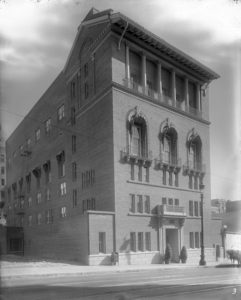How 640 Sutter Street came to be listed in the National Register of Historic Places

Gabriel Moulin, photographer
On November 30, 2004, the 640 Heritage Preservation Foundation sponsored a gala “plaque unveiling” celebration at 640 Sutter Street. The reception took place in the elegant and historic main dining room with tours of the building offered throughout the evening. It was attended by City Supervisor Aaron Peskin, the Executive Director of San Francisco Heritage, the Director of the Western Office of the National Trust, members of the State Historic Resources Commission and San Francisco’s Landmarks Preservation Advisory Board, other city officials and local preservationists. Emilie Plake, beloved past president of the Metropolitan Club, did the actual unveiling and the plaque was then taken to the street and permanently affixed to the façade.

That same day, the San Francisco Board of Supervisors extended “its highest commendation to the [Metropolitan] Club for its example of Stewardship” and declared November 30, 2004, to be Metropolitan Club Day in San Francisco.
Today, the celebrated plaque is on view to all who walk along Sutter Street, noting 640 as the site of the first woman’s athletic club in the Western United States, founded in 1915.
What were the steps that led to this prestigious nomination?
The 640 Heritage Preservation Foundation had been incorporated in January 2004 in the State of California with the specific charitable and educational purpose of researching the heritage of the woman’s athletic club movement and the particular history of the Woman’s Athletic Club of San Francisco and providing opportunities for public education about this important piece of women’s history. From the beginning, the Foundation’s mission was grounded in the firm belief (1) that preserving an historic resource of the caliber of 640 Sutter Street is an important public benefit and (2) that the story of how and why the first woman’s athletic club west of the Mississippi came to be, and its role in the influential women’s club movement of the early 20th century, is a story worth sharing.
The incorporation documents named well-known preservation architect Alice Ross Carey, past Metropolitan Club president Olga Dollar and community preservationist Carol Ann Rogers as the founding directors and officers. The Foundation held its first Board meeting on January 28, 2004. Rogers was elected President, Dollar, Vice President, and Carey, Treasurer and Secretary.
They then quickly moved to preparation of the National Register nomination.
Prominent architectural historian Michael Corbett was engaged to conduct the necessary research and to write the nomination documents. A review of San Francisco’s inventory and ratings of historic buildings quickly verified that an historic resource worthy of nomination to the National Register of Historic Places (NRHP) was present at 640 Sutter Street for at least its architectural significance. Corbett recommended that it might also qualify for one of the other potential listing criteria under its social history as the first women’s athletic club west of the Mississippi. The Foundation authorized the additional research needed to nominate the Woman’s Athletic Club under this additional criterion.
Once written, the nomination needed local and state approvals. First stop was the San Francisco’s Landmarks Board (now the Historic Preservation Commission) that not only approved the nomination but voted to add to the staff’s recommended wording that they ‘applauded’ our inclusion of the social heritage and history of the Club, as well as the architecture, and that our actions were an outstanding example of good stewardship. Foundation Director Alice Ross Carey was well-known to the Board and her presence at the hearing helped ensure success. With local approval in hand, the Foundation moved forward to secure state approval.
“It was my great privilege to attend the April 21, 2004 meeting of the California State Historic Resources Commission where one of the commissioners singled out our nomination as ‘one of the most beautifully written and researched nominations’ she had ever seen,” recalls Rogers. “She went on to say that it was an example of what a nomination should look like, and hoped that she would one day see it in print [other than on the government nomination forms]. The excellent research was done by historian Michael Corbett [whom the Foundation had] engaged to prepare the National Register nomination describes a rich and proud history and is full of wonderful anecdotes.”
In September, the Foundation received word that the Woman’s Athletic Club of San Francisco nomination had been signed by the Keeper of the National Register of Historic Places on September 17, 2004. In early 2005, the Foundation learned that the Woman’s Athletic Club would be featured on the NRHP website that March to celebrate women’s history month.